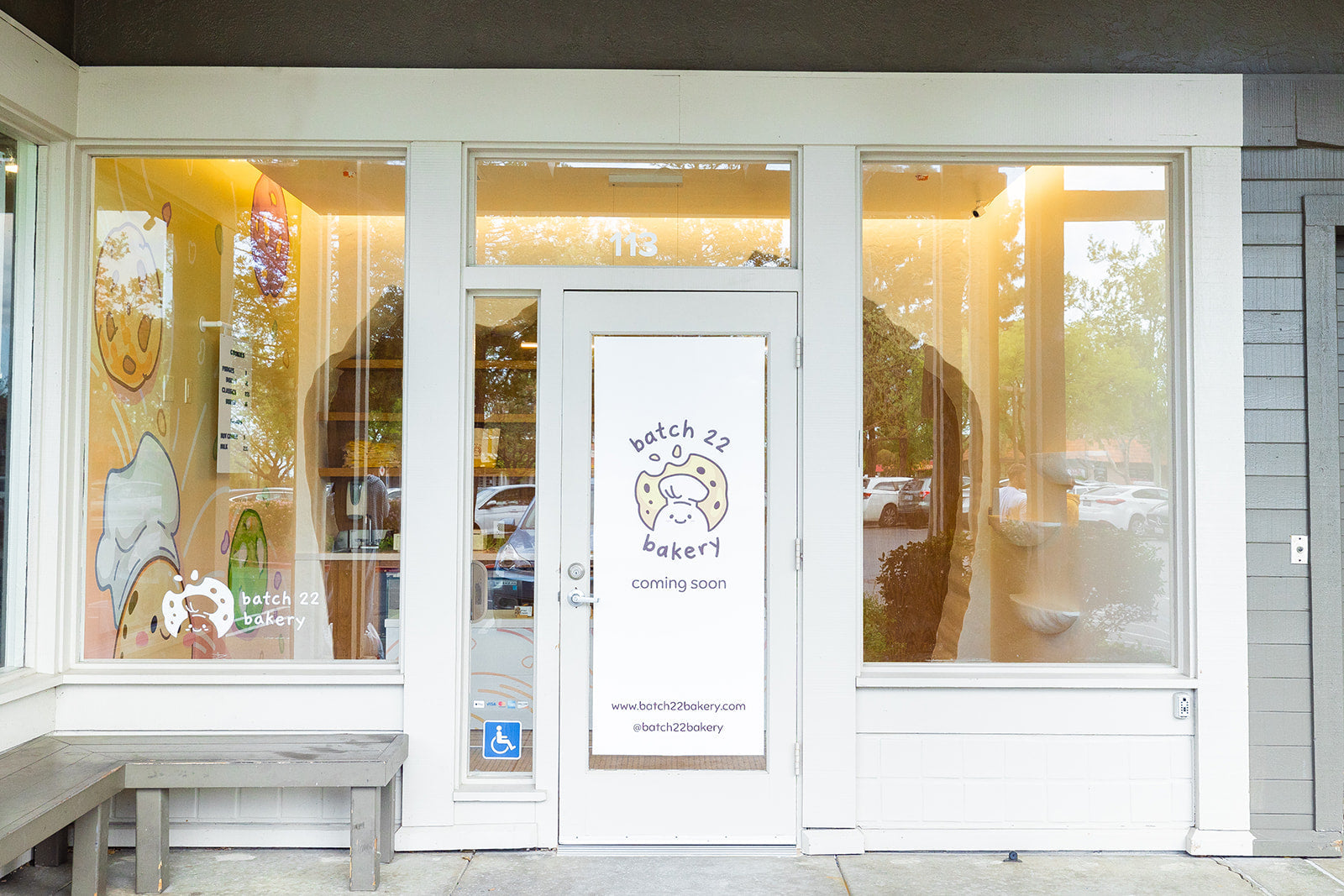Home Bakery to Storefront: Part 2 of 2

I posted Part 1 of this journey in 2022, and how naive we were. It was what we thought would comprise the entirety of opening a storefront, but let’s treat this as our post mortem as well as a peek under the hood.
I’m picking up from Part 1’s step 6 - sourcing a location. This is where every single part of the process had a million tiny steps.
- If you get lucky, you could wait and find the perfect asset purchase of a 2nd gen restaurant. Unfortunately, everyone wants that.
- When looking at spaces, a lot of landlords wanted to see food businesses who had 1 or more existing brick & mortar. They were a lot pickier than expected.
- We went through several brokers, but many of them gave up on us. Our brokers at Keller Williams stuck through it with us, found us a space, and gave good advice.
- We were 3 months into negotiating a contract for a former Vietnamese sub shop when the landlord wanted us to take a different space 2 doors down - a former electronics store that was smaller.
- Negotiations took us a total of 5 months - every single iteration took about 3 weeks. It was brutally slow, but our advice to others is to always get a lawyer for this step. Despite the cost, the contracts are extensive and come with severe consequences. Fun fact: your business structure does not prevent the landlord from having you sign your house as collateral (if you own), or having you sign a personal guarantee if you default on your rent.
Architectural Work
- We dealt with an extremely risky timing situation: our lease stipulated that we needed to have architectural plans submitted within 2 weeks of signing the lease. But sometimes you can have plans drawn up when you think you’re close, and lose the lease. (Yes, this did happen once)
- Once you have the plans - you can get contractors to bid on the project. Then you can get an idea of the cost.
- I won’t spell it out, but you can see where things can get extremely dicey here due to tight timeline and everything being reliant on each other.
- Friendly advice on this part is: choose an architect who’s worked in the city/town you’re building in.
- One of the biggest holdups that delayed our construction was the fact that we ended up with plans that were supposed to be in our budget, but were seriously, prohibitively… not. We could not afford the build for a long time.

Construction
- Our buildout was “a 12 week project”. Hahaha, I hope this becomes funny someday. We finished in 38 weeks.
- It’s hard to know what’s in your power as the client because the GC would in theory manage all subcontractors, scheduling them in correct order, on a timeline that works for us, and then get us to pass inspections. So if they are doing that, what can you be responsible for? How can you help the process stay on track?
- If we did this again, I would have a better idea of all the equipment I plan to use - specifically to help dictate electrical needs/outlet placement. I would double check our shelf depth as well because that can affect appliance placement. And I would leave a few extra inches of space on the oven side of our wall. There were large “disconnects” for our oven that ate up several inches that we didn’t have.
- I would have our point of sale system placement dialed in (exactly which products, if they need power/data, and where they’ll be used). I’d have thought about security cameras earlier (power/data), and I would think about coffee as early as the architectural planning stage (water filtration and water lines, which brewer(s), power needs, where we need holes drilled into the counter, etc.).
- We did expect that this project would follow the industry standard “twice the timeline, twice the budget” rule of thumb. Around mid-February was when we realized our project was extremely behind. I ended up project managing very heavily once we were more built out (after framing/electrical was done), but even with extreme persistence, there are *so* many subcontractors (keep in mind none of them work for our GC, so they all have other jobs), vendors, inspections. So much was out of our control. We could only try to keep things on track and do everything in our power to knock out the million tasks.

Back of House
Equipment
- Equipment is finalized well before you begin the buildout. Check your door width in the planning stage. Be there for the big deliveries. Literally just sit there and wait.
- We experienced an uncanny amount of equipment issues: weeks of delay without ETA, product discontinuations without notice (our supplier delivered the wrong product model…), new equipment having issues [oven & freezer], equipment not arriving at all. I guess it helped that our buildout kept getting delayed, so we had the time to resolve all of these issues. We got a lot more scrappy with Webstaurant, KaTom, and going to local stores. Now that we know that everything that can go wrong, will go wrong, we know how to play it for next time.
- Our dishwasher was a persistent problem - it turns out something had broken in transit, and it failed to reach temp during multiple health inspections. They let us pass, but it was tedious to continue working with the vendor so frequently.
Unexpected Issues and Fun Facts
- HVAC took ~8 weeks because the mechanical team had to go through an upstairs tenant’s unit. The landlord/property manager doesn’t always have a process for this so we worked with the good graces of the upstairs folks.
- The restroom sink was severely clogged and extreme measures (and much much more time) had to be taken to fix it
- The fire extinguisher can’t be installed by anyone, need to be a special vendor
- Restrooms need closers on the doors due to ADA compliance, and the pressure on auto-closing doors needs to be extremely precise or you’ll fail either Building inspection
- Soaps and paper towel dispensers had to be at ADA compliant height, along with one of our employee lockers - which also need a certain clearance around and above them. Lots of things are very very particular for ADA compliance, or maybe it’s just where we are.
- Our flooring was crazy coarse for anti-slip (and subsequently impossible to clean) and we had to have it sanded down and re-done. Someone should have caught this but…
- Sinks and dish tables have to be bolted into the wall and caulked
- We had an electrical issue and had to get onto a new breaker (200 amps) - we had no power for ~1.5-2 weeks
- Shelving that’s >6’ tall needs to be bolted to the floor
- Our GC didn’t realize until 1 week too late that we needed power to the POS. We ended up pivoting to a wireless handheld device.
- Outdoor signage design, landlord approval, and permitting took 6 weeks. The rules were extremely strict. The turnaround time for signage is also several weeks, so… we would have started this way sooner had we known.
- Mural: our original plan was to have our designer paint, but we ended up going with vinyl print. We would do this again!
- Plaster cookie wall: This was some wildly creative work (thank you, Architect), and the plaster team were absolute wizards. When they were on the job, they were all-in - coming early and staying late. No one could have done a better job.

Mural by our friend & designer Emily Cheng
Passing Inspections
- There are so, so, so many inspections. There were multiple building inspections throughout the buildout, an above-ceiling inspection, building final, a fire sprinkler inspection, and a fire life and safety inspection. Then pre-final and final health inspection, and a certificate of occupancy. I probably haven’t captured all inspections. It’s a constant moving target, nearly impossible to pinpoint when you can open until you start passing these finals.
- If your contractor does a decent job, you wouldn’t (in theory) get flagged for too many things, but between the pre-final and final health (which in theory is the hardest), there’s usually a to-do list. Every inspector is a little different.
Hiring and training staff
Oh, my - we got so incredibly lucky here. Expecting a March opening, we started training new BoH staff in our Fall busy season, got tons of feedback on our kitchen processes, and improved things immensely. Some of those staff left, but we started training new staff in early 2025 and continued to test and improve our processes. This was all documentation, very unsexy, tedious work, but came with high payoff. We haven’t done much training for FoH, but I think we are blessed with great staff all around.
How does it feel now?
We are so worn out from this marathon. It is a relentless and unforgiving process, with a million people, a million steps, and a million problems to solve. It’s taken every ounce of energy, effort, and care we had to give - and then some. We would do it again. We would do it better. It’s conflicting to be at the finish line of a huge project, feeling like we’re supposed to be purely thrilled, but exhausted.
This process has taught us the discipline to be grateful for the small things. We'll enjoy the immense support of our customers, friends, family, and staff. We have the rare honor of seeing five years of intense work culminate into something so life-changing and we don't forget it. Thank you for reading, and thank you for your support. We’re looking forward to serving you.
- Amy & Lawrance
Batch 22 Bakery | 15466 Los Gatos Blvd Ste 113 Los Gatos CA 95032
